Layman D. Biology Demystified: A Self-Teaching Guide
Подождите немного. Документ загружается.


them are in a state of diastole, so that they receive blood through the right
and left atrioventricular valves.
The Cardiac Cycle is one heart beat or one complete cycle of contraction
(systole) plus relaxation (diastole) of all four chambers of the heart. There are
also at least two heart sounds that can be heard through a stethoscope placed
onto the chest or back. The 1st heart sound is commonly described as ‘‘lubb.’’
It is due to closure of both A-V valves, which occurs when the ventricles start
going into systole. The ventricles push the A-V valve flaps shut from below.
As a result, a back-flow of blood from the ventricles, and back up into the
atria, is usually prevented.
The 2nd heart sound is usually represented as ‘‘dupp.’’ This sound occurs
because of the closing of both semilunar valves at the beginning of ventri-
cular diastole. The blood in the common pulmonary artery/aortic arch above
each ventricle starts to fall back downward, due to the force of gravity. As
the blood falls down, it catches the semilunar valve flaps and slams them
shut, thereby preventing a back-leak into the ventricles. [Study suggestion:
Glance back at Fig. 16.3, to help you visualize what’s happening during the
two heart sounds.]
HEART MURMURS
Sometimes the heart valve flaps do not fit tightly together. Consider what
may happen after bacterial endocarditis (en-doh-car-DIE-tis). This disease
involves an ‘‘inflammation of ’’ (-itis) the ‘‘inner’’ (endo-) lining of the
‘‘heart’’ (cardi), due to infection with bacteria. During the process of inflam-
mation, the flaps of certain valves (especially those of the left A-V valve)
become swollen. When the inflammation finally heals, the valve flaps may
become pulled back and distorted.
Thus, there is a turbulent (TUR-byuh-lunt) back-flow of blood – a back-
flow which is highly disorderly and in a state of ‘‘turmoil’’– through the
distorted and ill-fitting heart valve flaps. The resulting noisy, abnormal
heart sounds are called a heart murmur.
Blood Pressure and Blood Flow
In general, blood pressure (BP) is a pushing force exerted against the blood
and against the walls of the blood vessels (see Figure 16.4). The blood pres-
sure (BP) is at its highest in the major arteries attached directly to the heart
CHAPTER 16 Blood and Circulatory System 287
[13:26 13/6/03 N:/4058 LAYMAN.751/4058-Alltext.3d] Ref: 4058 Layman: Biology Demystified All-text Page: 287 1-388
3, Order
1, Disorder
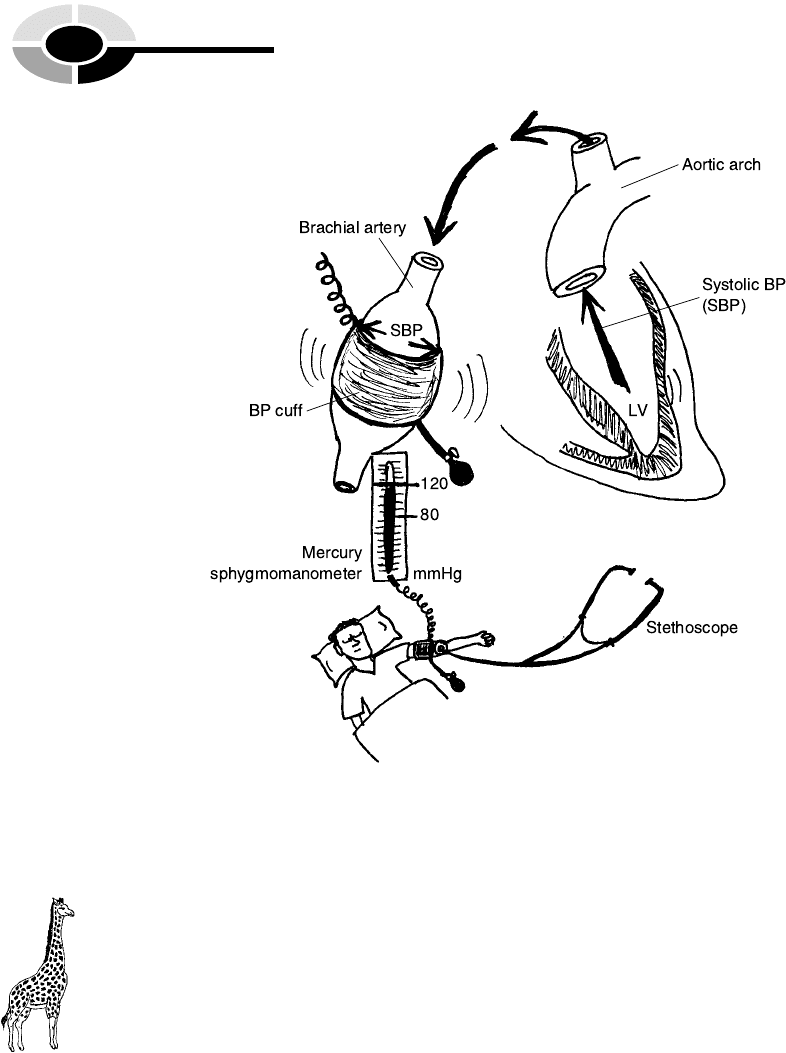
(such as the aortic arch and common pulmonary artery). The BP then pro-
gressively decreases with greater distance from the heart.
Blood pressure is critically important because it is the main force causing
blood flow. There is a blood pressure gradient (GRAY-dee-unt), a series of
downward ‘‘steps’’ from a region of higher to a region of lower blood pres-
sure. Within the systemic circulation, for example, the BP is highest within
the aortic arch. As the aortic arch progressively branches into smaller and
smaller arteries farther away from the heart, the BP also declines. This creates
a blood pressure gradient or series of downward steps in blood pressure in
vessels farther from the heart. Hence, the blood is pushed down a BP gra-
dient, so that it flows into lower-pressure arteries in a series of steps.
One of these farther arteries is called the brachial (BRAY-kee-al) artery,
which is named for its location within the upper ‘‘arm’’ (brachi). The brachial
artery is the most frequent site used for taking someone’s blood pressure,
[13:26 13/6/03 N:/4058 LAYMAN.751/4058-Alltext.3d] Ref: 4058 Layman: Biology Demystified All-text Page: 288 1-388
PART 4 Anatomy and Physiology of Animals
288
Fig. 16.4 Blood pressure (BP), blood flow, and the brachial artery.
4, Order

utilizing a stethoscope and sphygmomanometer (sfig-moh-muh-NAHM-uh-
ter). A sphygmomanometer is literally ‘‘an instrument used to measure’’
(-meter) the ‘‘throbbing pulse’’ (sphygmo) at certain ‘‘intervals’’ (mano).
To be sure, one does hear a dull throbbing sensation when the bell of a
stethoscope is placed over the brachial artery and the arm cuff of a sphyg-
momanometer device is inflated around it. The sphygmomanometer is
usually marked off in units of millimeters of mercury, abbreviated as
mmHg (Hg is the chemical symbol for the element, mercury).
As the air is slowly let out of the inflated arm cuff, the first dull throbbing
noise one hears through the stethoscope is called the systolic (sis-TAHL-ik)
blood pressure,orSBP. The systolic blood pressure (SBP) is the pressure
created by the systole (contracting and emptying phase) of the left ventricle
of the heart. A slug of blood is pushed out of the left ventricle with its con-
traction. Flowing progressively down a BP gradient, this slug of blood finally
enters the brachial artery. The blood bulges out the artery somewhat as it
passes through it, thereby creating a thumping sound. For a resting adult, the
systolic blood pressure (SBP) is usually recorded as about 120 mmHg.
The diastolic (DIE-ah-stahl-ik) blood pressure,orDBP, is the blood pres-
sure associated with the diastole (relaxing and filling) phase of the left ven-
tricle. Upon thoughtful reflection, you might well ask, ‘‘Why isn’t the
diastolic BP just 0 mmHg? Isn’t diastole the resting and filling phase, when
the ventricle isn’t even contracting or creating any blood pressure? So, why
should there even be any diastolic BP, at all?’’
Good question! Glance back at Figure 16.4. Note that the brachial artery
bulges out with the force of the systolic BP against its walls. Now, when the
ventricle stops contracting, and diastole begins, there is a powerful elastic
recoil, or snapping back force, created by the stretched brachial artery wall
coming back to its non-stretched shape. This force of elastic recoil or snap-
ping back of the stretched brachial artery wall is what creates the diastolic
BP. The diastolic blood pressure is, then, in a sense, a residual or left-over
blood pressure, the force of blood pressure temporarily ‘‘stored’’ in the
bulged-out walls of the brachial artery during systole. Because it is a residual
BP, the diastolic BP is normally significantly lower than the systolic BP. It
averages about 80 mmHg in a resting adult.
The stethoscope and sphygmomanometer measure a resting adult’s blood
pressure as about 120/80 mmHg. The SBP is 120, the DBP is 80. The diastolic
BP is usually recorded as the level of blood pressure where the dull thumping
sound heard through the stethoscope just disappears. [Study suggestion: Ask
yourself, ‘‘Why does the thumping sound disappear just below the recorded
level of the diastolic BP?’’ Hint: Think about what is happening to the wall of
the brachial artery.]
CHAPTER 16 Blood and Circulatory System 289
[13:26 13/6/03 N:/4058 LAYMAN.751/4058-Alltext.3d] Ref: 4058 Layman: Biology Demystified All-text Page: 289 1-388
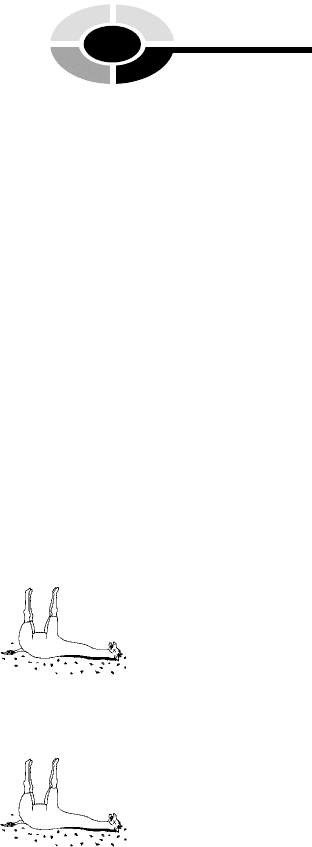
Hypertension, Hypotension, and
Arteriosclerosis
We have been talking about the normal blood pressure, which has an average
or set-point level of about 120/80 mmHg. The normal BP can rise to an upper
limit of about 140/90 mmHg. And it can fall down to a lower limit of about
100/60 mmHg. The distance between these upper and lower normal readings
creates the normal range for blood pressure, a condition that can technically be
called normotension (NOR-moh-TEN-shun). We use this term because blood
‘‘pressure’’ represents the amount of tension exerted against the blood. Figure
16.5 (A) illustrates a state of normotension: that is, a state of relative con-
stancy or homeostasis of blood pressure within its normal range.
Unfortunately, however, blood pressure doesn’t always remain within its
normal range. Say that a lumberjack accidentally cuts his brachial artery with
a chainsaw while felling a large oak tree. The blood spurts out in hot red jets,
resulting in a severe and possibly fatal hemorrhage (HEM-uh-rij) – a ‘‘burst-
ing out’’ (-orrhage) of ‘‘blood’’ (hem). When so much blood is lost, there isn’t
much blood left to press against the arterial wall. Thus, blood pressure
steeply declines. It may even reach a state of hypotension (HIGH-poh-
TEN-shun). Hypotension is a condition of ‘‘below normal or deficient’’
(hypo-) blood ‘‘pressure’’ (tens). Specifically, hypotension is a blood pressure
significantly less than 100/60 mmHg (Figure 16.5, B).
At the opposite extreme lies hypertension (HIGH-per-TEN-shun) – an
‘‘excessive or above normal’’ (hyper-) blood pressure. Hypertension is a
blood pressure significantly above the upper normal limit of approximately
140/90 mmHg (Figure 16.5, C).
‘‘So what if a person has hypotension or hypertension?’’ a skeptic might
inquire. With hypotension, the person may easily faint. And if the condition
is severe, there may be circulatory shock or coma, due to a lack of blood
pressure pushing blood up to feed the brain. In the case of hypertension, the
chronically above-normal pressure may overstretch and thin out the walls of
arteries, creating aneurysms (AN-yuh-riz-ums). Aneurysms are abnormally
‘‘widened up’’ arteries, which are highly susceptible to being ruptured. And
when an aneurysm ruptures, there may be a large amount of internal bleed-
ing. Persons suffering a stroke, or cerebrovascular (seh-REE-broh-VAS-kyoo-
lar) accident, for instance, may well have experienced a ruptured aneurysm of
their cerebral blood vessels covering the brain. Whatever particular body
functions the oxygen-and-blood-deprived brain area carried out, are then
partially or totally lost.
[13:26 13/6/03 N:/4058 LAYMAN.751/4058-Alltext.3d] Ref: 4058 Layman: Biology Demystified All-text Page: 290 1-388
PART 4 Anatomy and Physiology of Animals
290
2, Disorder
3, Disorder
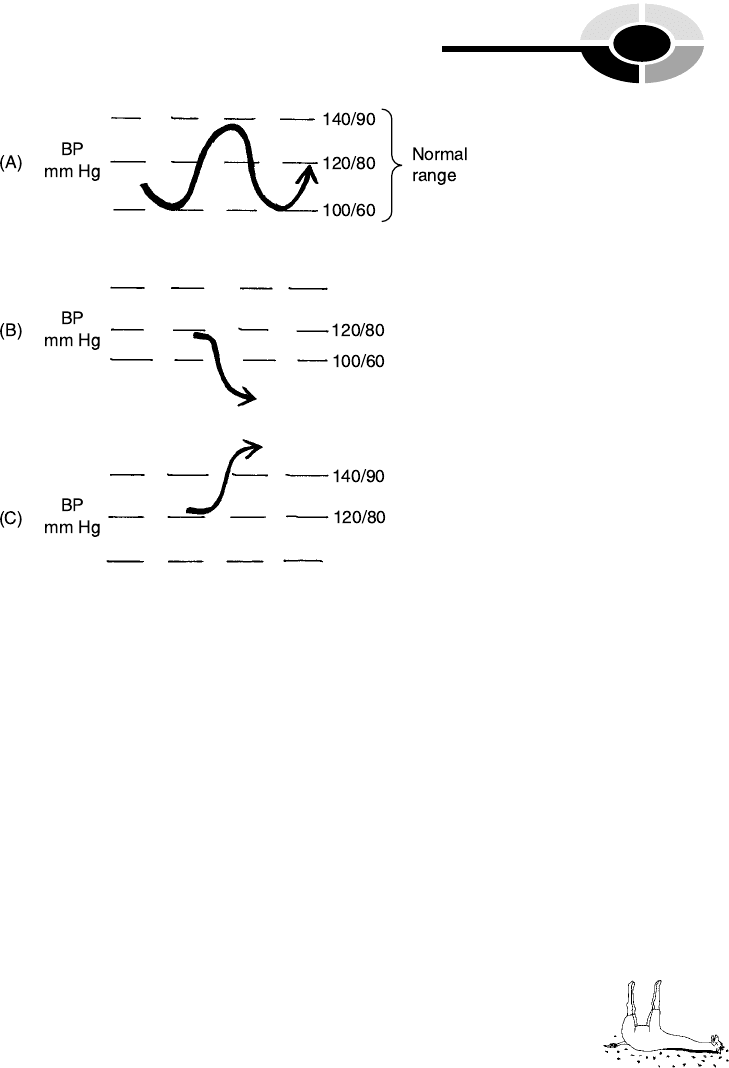
ARTERIOSCLEROSIS
Closely related to hypertension is the condition called arteriosclerosis (ar-
teer-ee-oh-sklair-OH-sis). Arteriosclerosis is ‘‘an abnormal condition of ’’
(-osis) ‘‘hardening’’ (scler) of the walls of an ‘‘artery’’ (arteri).
There is a positive feedback relationship between arteriosclerosis and
hypertension. You may remember (Chapter 14) that a negative feedback
system removes or corrects a particular change. It thus tends to re-establish
or maintain a state of Biological Order.
Positive feedback, however, is a system that magnifies or accelerates
change in some particular direction. Whatever is happening already, positive
feedback makes it even more extreme, or worse. Thus, positive feedback
is sometimes referred to as a vicious cycle. It magnifies or accelerates changes
that often veer out of control, thereby promoting Biological Disorder.
Consider hypertension and arteriosclerosis (Figure 16.6). When the BP is
consistently elevated above its normal range, then it tends to damage the
elastic fibers within the arterial walls. [Study suggestion: Picture a garden hose
CHAPTER 16 Blood and Circulatory System 291
[13:26 13/6/03 N:/4058 LAYMAN.751/4058-Alltext.3d] Ref: 4058 Layman: Biology Demystified All-text Page: 291 1-388
Fig. 16.5 The three possible states of blood pressure (BP). (A) Normotension. (B) Hypo-
tension. (C) Hypertension.
4, Disorder
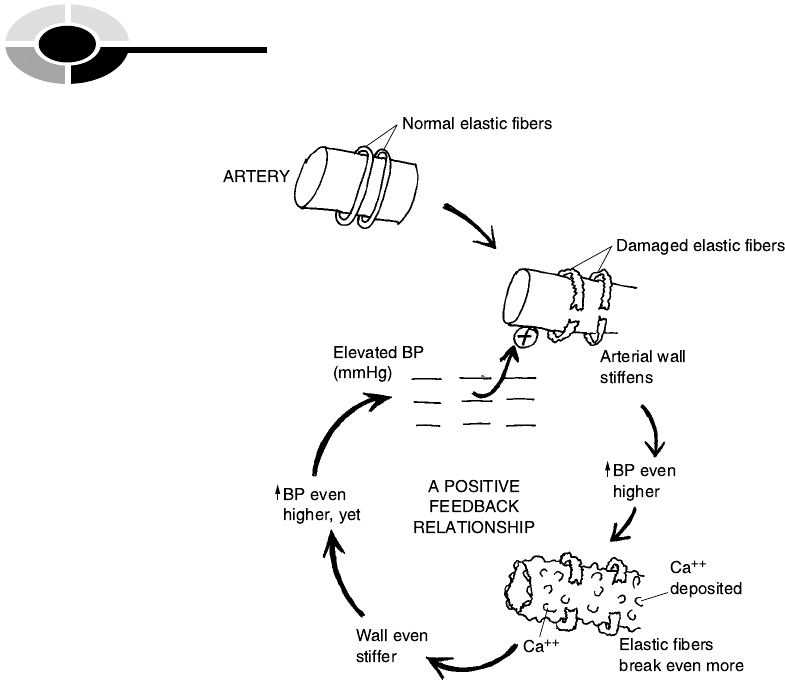
with an adjustable nozzle at the end. It is attached to a faucet that is left
turned on all summer, with the nozzle closed. What will eventually happen to
the garden hose?] When the elastic fibers are damaged, the arterial wall gets
stiffer, and when the arterial wall gets stiffer, the BP goes up even more. This
makes the hypertension worse. And as the hypertension worsens, the elevated
pressure damages the elastic fibers to an even greater extent.
Hence, there is a positive feedback relationship (vicious cycle) between
hypertension and arteriosclerosis. The worse the hypertension gets, the
more the arterial wall hardens, and the more the arterial wall hardens, the
worse the hypertension gets. Adding to the damage, calcium ions are pushed
out of the bloodstream by the high BP, becoming embedded in the arterial
wall. So the once soft, pliable, garden hose-like normal artery progressively
transforms into a rock-hard, stiff, calcified (KAL-sih-feyed) tube that more
resembles a heavily limed-up lead water pipe!
[13:26 13/6/03 N:/4058 LAYMAN.751/4058-Alltext.3d] Ref: 4058 Layman: Biology Demystified All-text Page: 292 1-388
PART 4 Anatomy and Physiology of Animals
292
Fig. 16.6 Hypertension and arteriosclerosis: A positive feedback relationship. (NOTE: Blood
pressure is abbreviated as BP.)

The Blood Connective Tissue
Having discussed the heart as a pump and the blood vessels as tubes for
carrying flowing blood, it is now time to consider the blood itself. Blood is
a red, sticky, connective tissue that occupies about 5–6 liters (LEE-ters) of
volume in an average-sized adult.
PLASMA
At first, it may seem odd to classify blood as a connective tissue. After all, it
contains no connective tissue fibers (such as collagen or elastic fibers) that
directly strap body parts together. Nevertheless, blood is considered a special
connective tissue, because it contains plasma (PLAZ-muh). Plasma is the
clear, watery, intercellular substance found ‘‘between’’ (inter-) the ‘‘cells’’
(cellul) of the bloodstream. Because it circulates throughout the body within
the bloodstream, plasma acts like a functional connective tissue rather than a
structural one. Recall that hormones (Chapter 15), for instance, are First
Messengers secreted by the endocrine glands and carried throughout the
body within the bloodstream. It is the plasma, not the blood cells per se,
that does this functional connecting or carrying of the hormones towards
their various target cells.
The plasma is basically a saline (SAY-leen) or ‘‘salt’’-containing solution
consisting of 0.9% NaCl (sodium chloride) solute (Chapter 4) dissolved in
water solvent. In addition to carrying hormones, nutrients such as glucose
and O
2
, and waste products like CO
2
, the blood also contains a number of
important plasma proteins. Some of these plasma proteins are critical for
blood clotting. Still others play a role in such processes as body defense
from foreign invaders.
FORMED ELEMENTS IN THE BLOOD
Besides the plasma, there are also many formed elements within the blood-
stream. Formed elements are cells and cell fragments within the blood that
have a definite shape or form.
When a sample of human blood is stained and viewed under a compound
microscope (Figure 16.7), several major types of formed elements can be
identified. Most numerous among these are the erythrocytes (air-RITH-
roh-sights) or ‘‘red’’ (erythr) blood ‘‘cells’’ (cytes). Erythrocytes (red blood
cells) are anucleate (ay-NEW-klee-aht); that is, they are ‘‘without’’ (a-) any
CHAPTER 16 Blood and Circulatory System 293
[13:26 13/6/03 N:/4058 LAYMAN.751/4058-Alltext.3d] Ref: 4058 Layman: Biology Demystified All-text Page: 293 1-388
5, Order
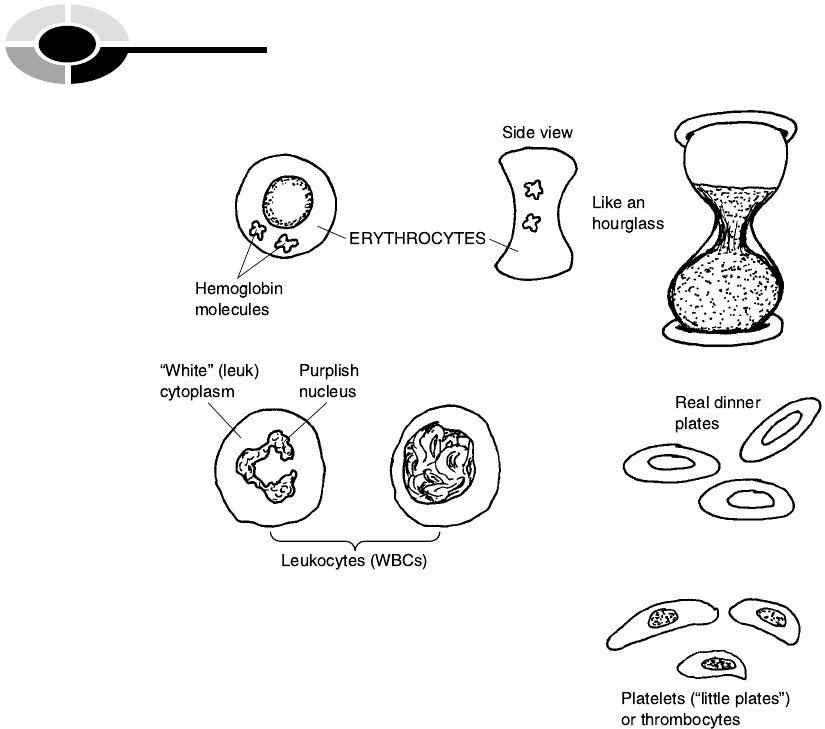
nucleus. They are also quite special in that they are shaped like biconcave
(buy-KAHN-cave) discs, being ‘‘caved-in’’ on ‘‘both’’ (bi-) sides. Viewed from
the side, this makes them look like red hourglasses! The red color is mainly
due to the presence of hemoglobin (HEE-moh-glohb-in). Hemoglobin is a
reddish-colored, ‘‘globe’’-shaped (glob), ‘‘protein substance’’ (-in) found
within the cytoplasm of the red ‘‘blood’’ (hem) cells. There may be as
many as 10,000 hemoglobin molecules present within a single erythrocyte.
The main job of these thousands of hemoglobin molecules is carrying oxygen
(O
2
) molecules through the bloodstream, and to the tissue cells.
Leukocytes (LEW-koh-sights) are the ‘‘white’’ (leuk) blood ‘‘cells’’ (cytes).
These cells typically have a large, purplish-staining nucleus, but they are
named for the clear, whitish appearance of their cytoplasm. (This is in
marked contrast, of course, to the red, hemoglobin-rich cytoplasm of the
erythrocytes.) The leukocytes have significant roles in protecting the body
from various foreign invaders. (Details are given in Chapter 17.)
[13:26 13/6/03 N:/4058 LAYMAN.751/4058-Alltext.3d] Ref: 4058 Layman: Biology Demystified All-text Page: 294 1-388
PART 4 Anatomy and Physiology of Animals
294
Fig. 16.7 The major formed elements of the blood.

The third common formed element are the platelets (PLAY-teh-lets)or
thrombocytes (THRAHM-buh-sights). The platelet name comes from their
shape – ‘‘little plate’’-like fragments of disintegrated bone marrow cells. The
thrombocyte name derives from their function – ‘‘clotting’’ (thromb) ‘‘cells.’’
About 1/3 the size of an erythrocyte, the platelets (thrombocytes) are scat-
tered here and there in small groups, throughout the plasma. These purplish-
colored, plate-like cell fragments have very sticky surfaces. Thus, whenever a
blood vessel ruptures and hemorrhages, the platelets soon collect around the
open hole and stick to a network of thin, ‘‘fiber’’-like strands, composed of
the protein, fibrin (FEYE-brin). As the platelets collect and stick to one
another, a ‘‘clot’’ or thrombus (THRAHM-bus) is soon formed. The hole is
blocked, hemorrhaging stops, and wound healing follows.
Serum Cholesterol, Atherosclerosis, and
‘‘Heart Attacks’’
When a person has a so-called ‘‘heart attack,’’ it usually involves a problem
with abnormal clotting or an occlusion (uh-KLEW-zhun) – ‘‘shutting up’’ – of
the blood vessels serving the myocardium. The site of the troublesome occlu-
sion (shutting up) is somewhere within the coronary (KOR-uh-nair-ee)
arteries. These vessels are named for their resemblance to a ‘‘crown’’
(coron) encircling the top of the heart, just below the auricles (OR-ih-kls)
or ‘‘little ear’’-like flaps. The right and left coronary arteries look like a red-
colored crown slipped down over the ears of a real prince (Figure 16.8, A)!
CHOLESTEROL AND ATHEROSCLEROSIS
The blood serum (SEER-um) is the clear, yellowish watery portion of the blood
plasma that remains after a clot (thrombus) has been formed. The blood serum
contains cholesterol (kah-LES-ter-ahl). Cholesterol is a white, fatty substance
that tends to be laid down as atheromas (ah-ther-OH-mahs) or ‘‘fatty’’ (ather)
‘‘tumors’’ (-omas) whenever its concentration becomes too high.
Atherosclerosis (ah-ther-oh-slair-OH-sis) is a fatty hardening of the arteries
that occurs when excessive blood cholesterol is deposited as atheromas (fatty
tumors) upon the inner walls of arteries. Atherosclerosis is especially harmful
in cases of coronary artery disease, where atheromas can build up and sud-
denly occlude (stop up) a coronary artery opening (Figure 16.8, B).
CHAPTER 16 Blood and Circulatory System 295
[13:26 13/6/03 N:/4058 LAYMAN.751/4058-Alltext.3d] Ref: 4058 Layman: Biology Demystified All-text Page: 295 1-388
5, Disorder
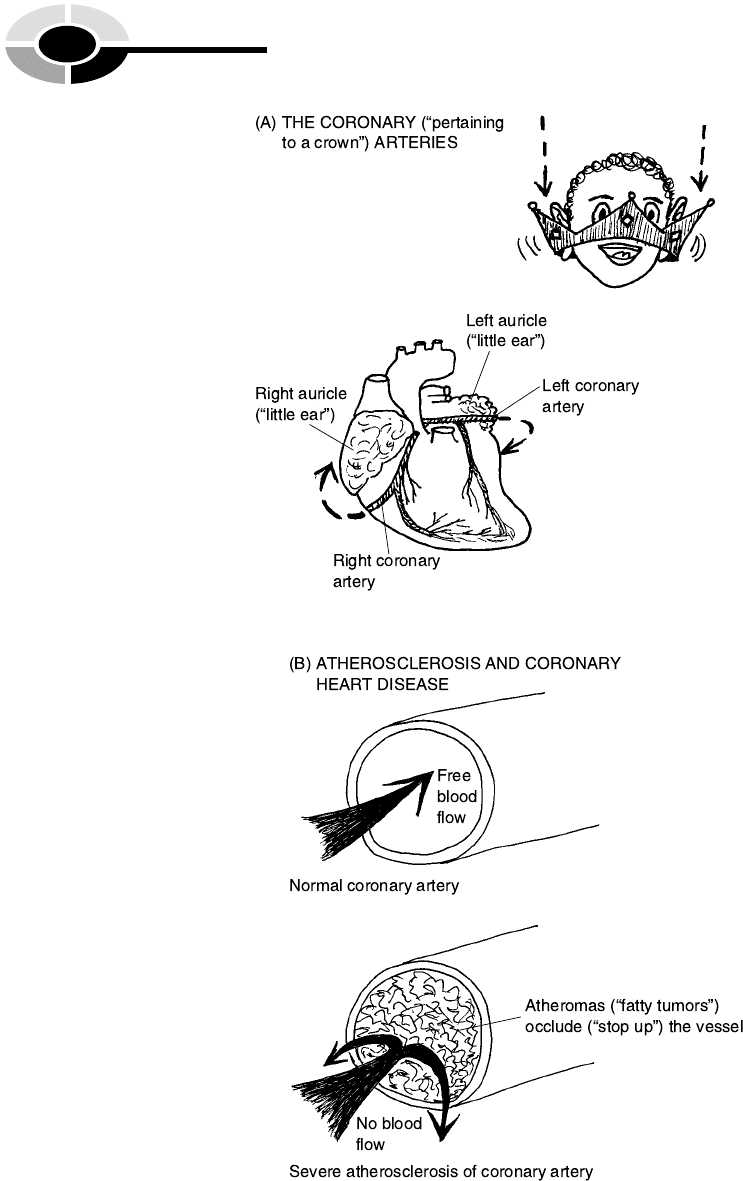
[13:26 13/6/03 N:/4058 LAYMAN.751/4058-Alltext.3d] Ref: 4058 Layman: Biology Demystified All-text Page: 296 1-388
PART 4 Anatomy and Physiology of Animals
296
Fig. 16.8 Atherosclerosis and occlusion of the coronary arteries.
